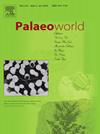Early Paleogene plant biomes of the Pacific side of Eurasia
IF 1.7
3区 地球科学
Q2 PALEONTOLOGY
引用次数: 0
Abstract
Major plant biome changes in East Asia during the early Paleogene are studied using the Integrated Plant Record vegetation analysis for the first time based on paleobotanical records. The paleobotanical record employed for the reconstruction comprises 110 paleofloras covering the early Paleocene to early Eocene, a time-span of ca. 17 Myr. Our data indicate the presence of more forested conditions over East Asia during the early Paleogene than at present. The early Paleogene vegetation cover in the study area fundamentally differed from modern and was much more homogeneous compared to the modern one. Mixed mesophytic zonal vegetation dominated on the Pacific side of Eurasia during the early Paleogene. Thermophilous mixed mesophytic forests were distributed even at very high latitudes, but at the same time, ecotone between the mixed mesophytic / broadleaved evergreen forests and broadleaved evergreen forest were confined to regions south of 50°N. The proportions of sclerophyllous plants are low in general, even in the mid-latitudes. The localities with open woodlands are all located south of ca. 45°N. The observed vegetation patterns and their changes throughout the early Paleogene in many cases can be correlated with climate patterns and the overall continental paleoclimate evolution as reconstructed from the paleobotanical record. The higher-than-present spatial homogeneity of early Paleogene vegetation coincides with shallow temperature gradients and a significantly more humid regional rainfall pattern over East Asia during the early Paleogene.
古近纪早期欧亚大陆太平洋一侧的植物生物群落
利用基于古植物记录的 "综合植物记录植被分析"(Integrated Plant Record vegetation analysis),首次研究了古新世早期东亚主要植物生物群落的变化。用于重建的古植物记录包括 110 个古植物群落,涵盖早古新世至早始新世,时间跨度约 17 年。我们的数据表明,早古新世时期东亚地区的森林覆盖率高于现在。研究区域的早古新世植被覆盖与现代植被覆盖有着本质区别,与现代植被覆盖相比,早古新世植被覆盖更为均匀。在古近纪早期,欧亚大陆太平洋一侧的混合中生地带性植被占主导地位。嗜热中生混交林甚至在高纬度地区也有分布,但同时,中生混交林/常绿阔叶林和常绿阔叶林之间的生态区仅限于北纬50°以南地区。硬叶植物的比例普遍较低,即使在中纬度地区也是如此。有开阔林地的地方都位于北纬 45 度以南。观测到的植被模式及其在整个古新世早期的变化在很多情况下都与气候模式以及从古植物记录中重建的整个大陆古气候演变相关联。古新世早期植被在空间上的同质性高于现在,这与古新世早期东亚地区较浅的温度梯度和明显湿润的区域降雨模式相吻合。
本文章由计算机程序翻译,如有差异,请以英文原文为准。
求助全文
约1分钟内获得全文
求助全文
来源期刊

Palaeoworld
PALEONTOLOGY-
CiteScore
4.00
自引率
5.90%
发文量
95
期刊介绍:
Palaeoworld is a peer-reviewed quarterly journal dedicated to the study of past life and its environment. We encourage submission of original manuscripts on all aspects of palaeontology and stratigraphy, comparisons of regional and global data in time and space, and results generated by interdisciplinary investigations in related fields. Some issues will be devoted entirely to a special theme whereas others will be composed of contributed articles. Palaeoworld is dedicated to serving a broad spectrum of geoscientists and palaeobiologists as well as serving as a resource for students in fields as diverse as palaeobiology, evolutionary biology, taxonomy and phylogeny, geobiology, historical geology, and palaeoenvironment.
Palaeoworld publishes original articles in the following areas:
•Phylogeny and taxonomic studies of all fossil groups
•Biostratigraphy, chemostratigraphy, chronostratigraphy
•Palaeoecology, palaeoenvironment and global changes throughout Earth history
•Tempo and mode of biological evolution
•Biological events in Earth history (e.g., extinctions, radiations)
•Ecosystem evolution
•Geobiology and molecular palaeobiology
•Palaeontological and stratigraphic methods
•Interdisciplinary studies focusing on fossils and strata
 求助内容:
求助内容: 应助结果提醒方式:
应助结果提醒方式:


